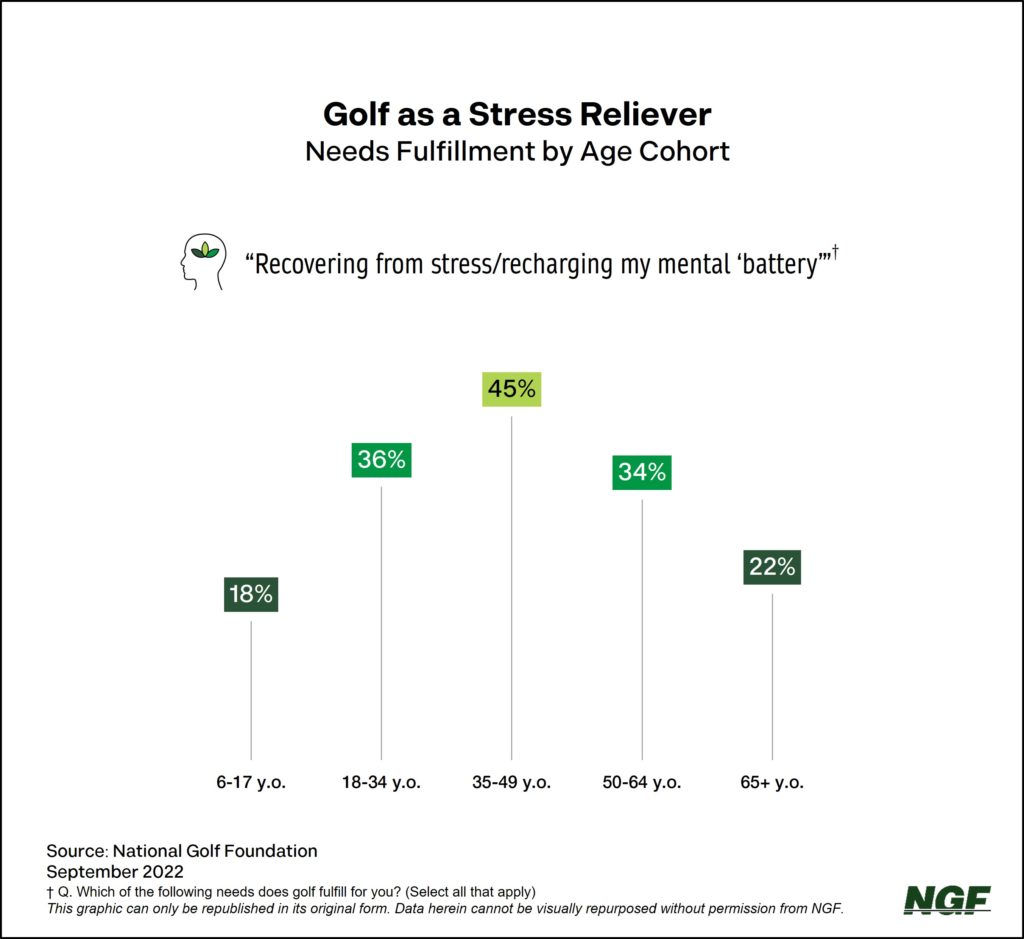Understanding Golf’s ‘Sandwich Generation’
(
It’s a bittersweet thing – giving up my status among the highly-dynamic, ever-evolving, often-vilified 18- to 34-year-old cohort. For the first time in my 10-year career at NGF, I’m no longer the self-proclaimed spokesperson for the “young crowd.” That torch has been passed.
Now, as I leave behind provisional adulthood and settle into this more refined life stage full of rapid personal development and major life transitions (I just got married), I find myself curious to understand my new peer group – the mostly-overlooked 35- to 49-year-olds. What makes us different? As golfers, how do our needs and behaviors contrast with other groups?
Turns out there are some interesting distinctions. Including foundationally – our motivations for playing golf skew differently than our younger and older counterparts. The biggest differentiator? For us, golf is a means to recover from stress and recharge the mental battery (this particular motivation charts like a bell curve across the age spectrum, as the graphic below illustrates).
That stress relief is a key driver for our group should make sense. This is a time in life when individuals assume the greatest number of social roles – worker, spouse or partner, parent, adult child – and must divide time and energy across these roles. Many of us are also part of what demographers call the “sandwich generation,” faced with the added time and financial pressures of raising young children and caring for aging parents. And of course these tend to be the most demanding years of a person’s career, too. Data from the Bureau of Labor Statistics (BLS) shows that people between the ages of 30 and 45 had the greatest increase in resignation rates between 2020 and 2021.[1]
You’ll believe then that golfers in my age group who are playing less golf these days – roughly 1 in 4 of us – most commonly rationalize that we have neither the time nor money to participate in the way or at the level we’d prefer. This is different from other groups. 18- to 34-year-olds are more likely to suggest they’ve throttled down because of finding other activities, while the 50-and-older crowd is slowed more by injury and the inability to find regular playing partners.
You’ll believe too that 35- to 49-year-olds are the most likely cohort to have played a solo round of golf over the past 12 months. More than 60% of us have, compared to 46% of all other golfers. This seems like a natural byproduct of the stress and time deficiency – you play whenever you can, even if you have to go alone. Or, you go alone anyway. Golf is certainly a social experience, but sometimes it’s a needed escape from the daily grind and other people.
So what do we do with this information? As marketers – which, like it or not, we all are – there’s nothing more powerful than knowing the underlying needs and wants of our consumer targets. Consider then how to build messages, products and experiences for a group that is under pressure and views golf as a break. Be relatable to that mindset. If what you’re selling or how you’re selling it feels familiar to people, that’s going to put you in a much stronger position to convince.
Want to understand your targets better? Let’s chat!
[1] https://hbr.org/2021/09/who-is-driving-the-great-resignation
_________________________________________________________
For a related Spotlight sidebar story on the differentiation in golfer age groups, click here
Fortnight.
"*" indicates required fields
How can we help?
NGF Membership Associate

"Moe"
Learn From NGF Members
 Ship Sticks Secrets to a Hassle-Free Buddies Golf Trip
Ship Sticks Secrets to a Hassle-Free Buddies Golf Trip
Whether you’re the head planner of your upcoming buddies golf trip or simply along for the ride, we’ve gathered a few easy ways to keep everyone in your group happy.
Read More... Golf Course Turf, Soil and Water Quality Diagnostic Testing
Golf Course Turf, Soil and Water Quality Diagnostic Testing
As humans, we see our primary care physician on a regular basis to proactively evaluate our vital signs. Likewise, a superintendent should perform frequent diagnostic testing on their golf course.
Read More... Unlocking Distance: Launch Conditions and Angle of Attack
Unlocking Distance: Launch Conditions and Angle of Attack
We’ve long known that higher launch and lower spin is a powerful combination for generating consistently long and straight tee shots. A key factor in optimizing launch conditions, one often overlooked, is ...
Read More...






